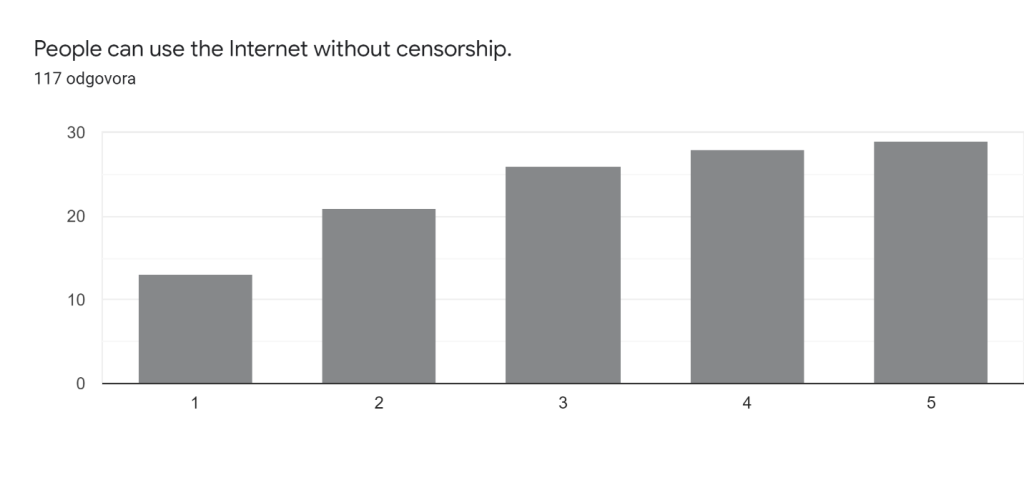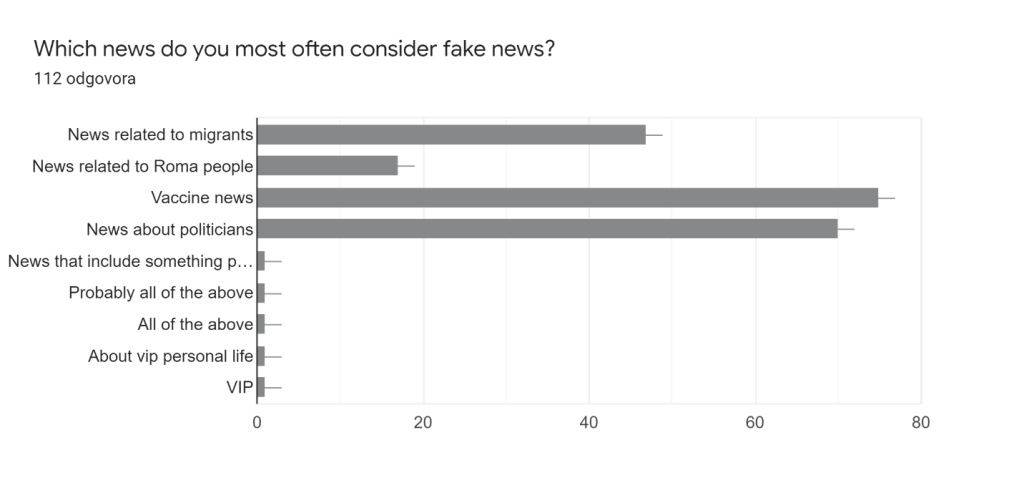The European Commission support for the production of this publication does not constitute endorsement of the contents which reflects the views only of the authors, and the Commission cannot be held responsible for any use which may be made of the information contained therein.
Fake information is considered to be synonymous with fake news? Experts now advise against using the phrase “fake news” or at least limiting its use because it is closely associated with politics, and this relationship can serve to reduce the scope of the problem. While fake news is more specifically defined as political news articles, the phrase false information is preferable because it may refer to a wide variety of disinformation spanning areas such as health, the environment, and economics across all platforms and genres.
As you are already familiar with, the SLAM project, conducted by Bosnian Representative Association for Valuable Opportunities – BRAVO (Bosnia and Herzegovina), Mine Vaganti NGO (Italy), Bulgarian Sport Development Association – BSDA (Bulgaria), Y.S.C. (Albania), Club for Youth Empowerment 018 – KOM18 (Serbia), NGO Mladiinfo Montenegro (m!M), and Egitim Programlari ve Evrensel ve Kulturel Aktiviteler Dernegi – EPEKA (Turkey), is focused on fake news and information, their detection and prevention.
In the past few months, the above-mentioned project consortium has conducted a survey on fake news among residents of seven countries, and we are presenting the survey results below.

As many as 117 respondents took part in the survey. The first question was related to age and 65%, or 76 participants, stated that their age range is 18 – 24. The following age range (25 to 30 years) was chosen by 17.9% or 21 participants. On the other hand, eight respondents, or 6.8%, said that they are 31 – 36 years old. As many as six answerers (5.1%) stated that their age range is from 37 to 45 years. Last, but not least, four participants (3.4%) answered they are over 45 years old, while 1.7%, or 2 participants, were under 18.

Regarding the second question about participants’ gender, 59% of participants, or 69 of them, were females, while 47 participants (40.2%) were males. Only one person, which statistically makes 0.9%, chose the option “Prefer not to say”.

Furthermore, Bosnia and Herzegovina is the most chosen option among the respondents – 55.6%, or 65 of survey takers stated this is the country they come from. Thirteen participants (11.1%) chose Turkey, while nine respondents (7.7%) chose Bulgaria. Both Montenegro, Italy and Albania were selected by eight participants, or 6.8 per cent. Six participants (5.1%) picked Serbia as their country.
Henceforth, survey became more precisely oriented towards media, fake news and migrants. That being said, let us see which are the most commonly used devices.
Mostly used devices are: Desktop PC – 6 participants, Laptop – 21 participants, Tablet – 1 participant, Smartphone – 89 participants
Least used devices, according to the survey, are: Desktop PC – 26 participants, Laptop – 46 participants, Tablet – 11, Smartphone – 18 participants, TV – 16 participants
Based on the survey responses, participants never use: Desktop PC – 20 participants, Laptop – 5 participants, Tablet – 69 participants, Smartphone – 2 participants, TV – 17 participants
Option “I don’t own any.” is chosen by 4 participants.


Next question was “How much time do you spend on your device(s)?” and 94 respondents (80.3%) said they spend over three hours using their device(s). As many as 21 participants (17.9%) claimed they spend between one and two hours on their device(s). Two participants (1.7%) chose the option “less than an hour”.
Next point in the survey is related to social networking sites (SNSs) and their usage. On the chart it can be seen that Instagram, Facebook, and Viber are the most commonly used SNSs, respectively. Telegram, TikTok, Twitter, and Snapchat are social networking sites that most people never use.
Facebook – mostly used by: 71 participants, least used by: 36 participants, never used by: 7 participants
Instagram – mostly used by: 88 participants, least used by: 12 participants, never used by: 16 participants
Twitter – mostly used by: 9 respondents, least used by: 21 respondents, never used by: 78 respondents
LinkedIn – mostly used by: 9 people, least used by: 44 people, never used by: 55 people
Snapchat – mostly used by: 13 participants, least used by: 22 participants, never used by: 72 participants
TikTok – mostly used by: 13 respondents, least used by: 18 respondents, never used by: 77 respondents
WhatsApp – mostly used by: 48 answerers, least used by: 36 answerers, never used by: 24 answerers
Viber – mostly used by: 42 examinees, least used by: 41 examinees, never used by: 27 examinees
Telegram – mostly used by: 4 assenters, least used by: 21 assenters, never used by: 81 assenters


Next question, as you can see on the chart below, was how much time people spend on reading news online. Nearly half percentage of testees (49.1%, 57 participants) chose the option “1-2 hours”. Option “Less than an hour” was chosen by 33.6% (39 participants), while 17.2% (20 participants) said they spend over three hours reading news on the Internet.
According to the survey, in Bosnia and Herzegovina, klix.ba, Radio Sarajevo and Dnevni avaz are the news sites which are participants’ go – to.

The next thing the consortium dealt with was on the basis of which some news could be trusted. Authority/ Source of the information was chosen by 85 participants (72,6%, while relevance was chosen by 50 participants (42,7%). Accuracy was selected by 35 participants (29,9%), timeliness of the information was selected by 32 participants (27,4%), and the purpose was picked by 28 participants (23,9%).


Do respondents fall for fake news, thinking it is real? As many as 83 participants (70.9%) said that they had been fooled by fake news thinking it’s real news, while 24 participants (20.5%) chose the option “maybe”. Ten participants (8.5%) said that they had not been fooled by fake news.

Next question was related to the level of “literacy” increased by the usage of technology and social media. A large number of participants, more precisely 73 of them (6.,4%) stated that they believe technology and social media made them a smarter/more informed person. As many as 29 participants (24.8%) chose the option “maybe”, while 12.8% (15 participants) claimed that technology did not make them smarter or more informed.
The upcoming set of questions and answers is very interesting. It deals with censorship. The suppression of speech, public communication, or other information is referred to as censorship. This could be justified if the material is deemed offensive, damaging, sensitive, or “inconvenient.”
Twelfth question was related to “ordinary” people and their free expression of opinion. Respondents could choose a “grade” from one to five, where one means “completely disagree”, while five means “completely agree”. A number of 12 participants (10.3%) picked the option 1, complete disagreement with the statement “People can say what they want without censorship.” As many as 19 participants (16.2%) stated that they disagree with the above – mentioned statement. Thirty-four participants (29.1%) were neutral about this question. Thirty participants (25.6%) agreed that they can freely express their opinions and ideas, while 22 participants (18.8%) completely agreed on the same thing.

Furthermore, the consortium asked the same question, but this time for media – are they able to report without suppression and censorship. Twenty – two respondents (18.8%) completely disagreed with the statement “The media can report news without censorship”, while 15 participants (12.8%) disagreed on the same statement. Thirty – four testees (29.1%) were neutral, whereas 24 participants (20.5%) agreed with the afore – mentioned statement. At the same time, 22 participants (18.8%) completely agreed that media can freely report news without repression.

Next statement was “People can use the Internet without censorship” and most respondents, 29 of them (24.8%) completely agreed with it. As many as 28 participants (23.9%) agreed with the same statement. Twenty – six participants (22.2%) were neutral, while 21 respondents (17.9%) disagreed with the above – noted statement. At the same time, 13 participants (11.1%) completely disagreed on this issue.

Regarding the topics which are most often considered as fake news, vaccine news is mostly recognized as such (75 participants, or 67%). News about politicians is being stated by 70 participants (62.5%) as fake news, while 47 participants (42%) claimed news related to migrants is often fake. News related to Roma people is being chosen by 17 participants (15.2%), while news about very important persons (VIP) and their life is stated to be fake by 2 participants.

The last question was particularly related to migrants and news about this population. Respondents were mostly neutral whether this kind of news is true (59 participants, 51.3%). Twenty – seven participants (23.5%) disagreed with the statement that the news about migrants is true, while 13 participants (11.3%) completely disagreed with this statement. At the same time, 11 participants (9.6%) agreed with this statement, and 5 participants (4.3%) completely agreed that the news about migrants is true.

In order to solve the problem shown in chart no. 10, the results of the survey presented will be of enormous importance in educating people about fake news. Based on the obtained data, the project partners will try to reduce the number of “victims” of fake news, increase tolerance, critical thinking, but also try to create the most inclusive environment for all. Stay tuned for all the activities.
